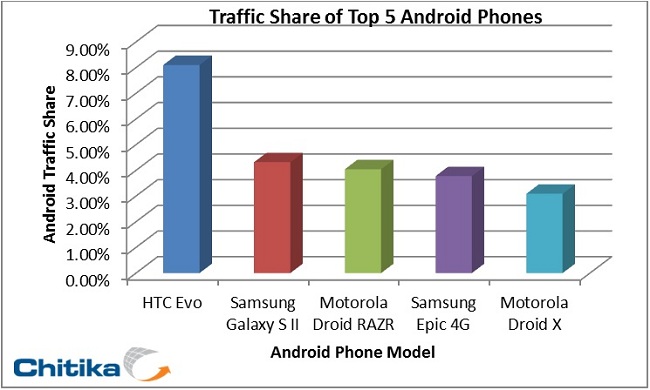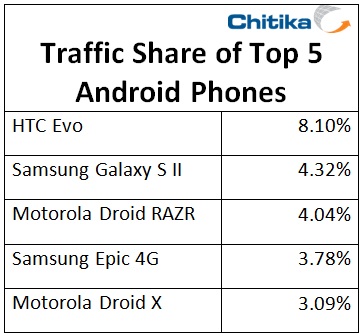The wide assortment of Android phone manufacturers has resulted in devices often constructed to appeal to particular user tastes or a market need. While Android users on the whole are less active on the Web as compared to iPhone users, the platform’s growing popularity prompted Chitika Insights to examine what usage patterns have developed in this more fragmented ecosystem. For this study, the Insights team researched which of the OS’ phone models are driving the highest rates of Internet usage.
Unlike Apple and its signature iPhone, every element of which the company develops itself, Google’s Android devices are only tied together by a common operating system (OS). The wide assortment of Android phone manufacturers has resulted in devices often constructed to appeal to particular user tastes or a market need. While Android users on the whole are less active on the Web as compared to iPhone users, the platform’s growing popularity prompted Chitika Insights to examine what usage patterns have developed in this more fragmented ecosystem. For this study, the Insights team researched which of the OS’ phone models are driving the highest rates of Internet usage.
To quantify this study, Chitika Insights took a sample composed of hundreds of millions of North American impressions from the Chitika Ad network, ranging from June 6, 2012 to June 12, 2012. A user agent analysis was then conducted on this sample of data to determine which devices were Android phones. The exact market share was then calculated based upon impression totals by device, compared to the total number of Android phone impressions seen over that time period.
Without a doubt, the biggest surprise of the study was that HTC Evo users leading in terms of total Web activity more than a year since our last study in this area crowned the device as the second-highest traffic consumer. The Samsung Galaxy S II and the Motorola Droid RAZR are the flagship Android devices for AT&T and Verizon respectively, and the phones tout some impressive specs when it comes to screen size and processing power. It would be expected that these phones, with their appeal to heavy Internet users, over the two most widely-used networks in the U.S, would be the most heavily utilized when it comes to Web browsing. Yet, the HTC Evo, an older, but flagship 4G device on Sprint’s network took this distinction – nearly doubling the traffic share of its closest competitor.
There are two likely contributors to Evo users’ dominance:
- The Evo’s time on the market (nearly two years versus about seven months for the Droid RAZR and Samsung Galaxy S II) means that more of those phones are in use within North America
- Sprint, unlike Verizon and AT&T, offers unlimited data plans to all of its users. By removing overage charges and similar fees, Sprint subscribers, and hence HTC Evo users, may use the Web capabilities of their phone on a more regular basis
For marketers and developers, this data has real implications when it comes to mobile Web optimization. Even for advanced applications, building only for the latest and greatest mobile devices can severely limit adoption rates.
Chitika Insights will be tracking these numbers moving forward, and will see how these trends develop with the next generation of mobile phones.

